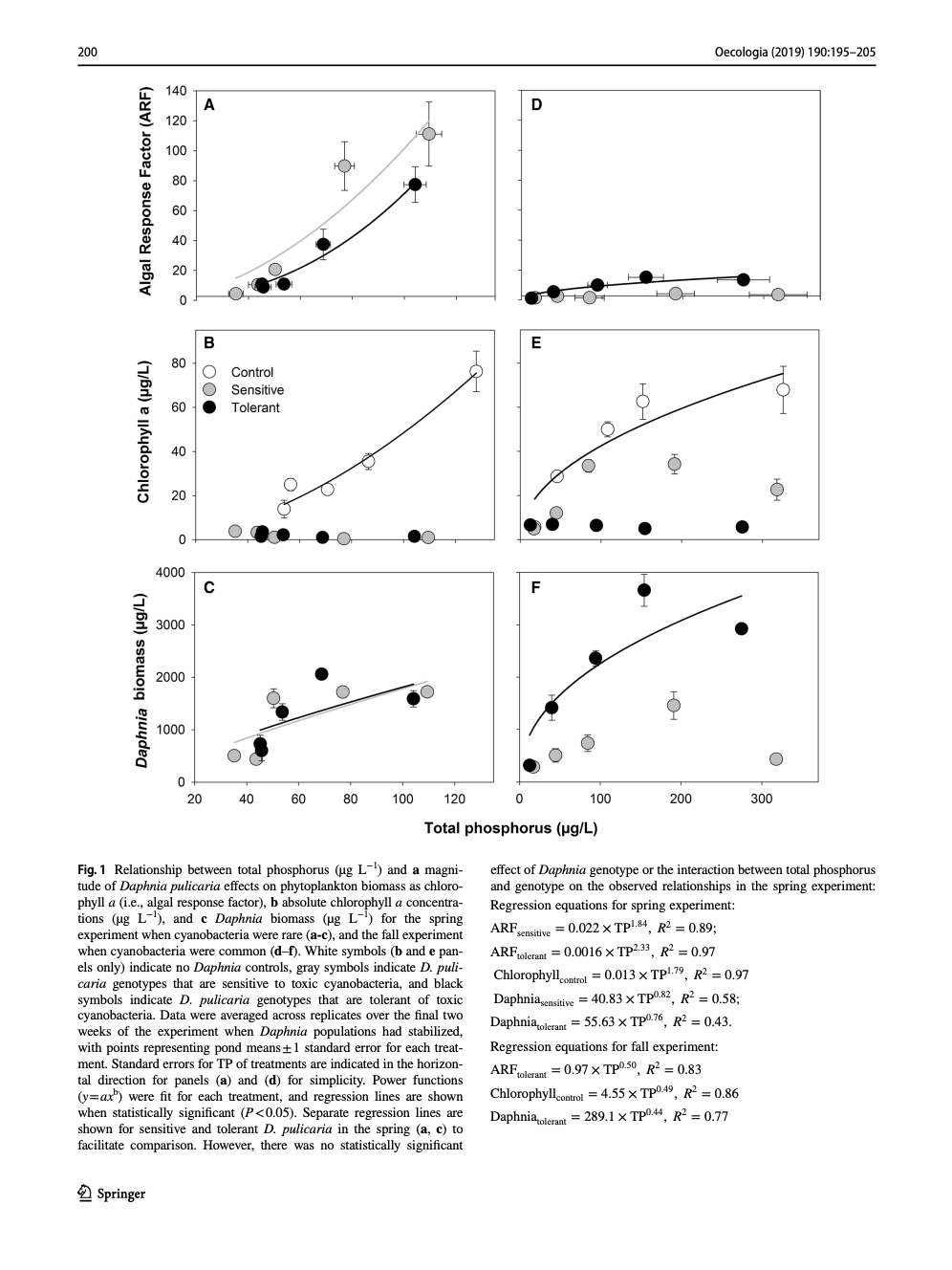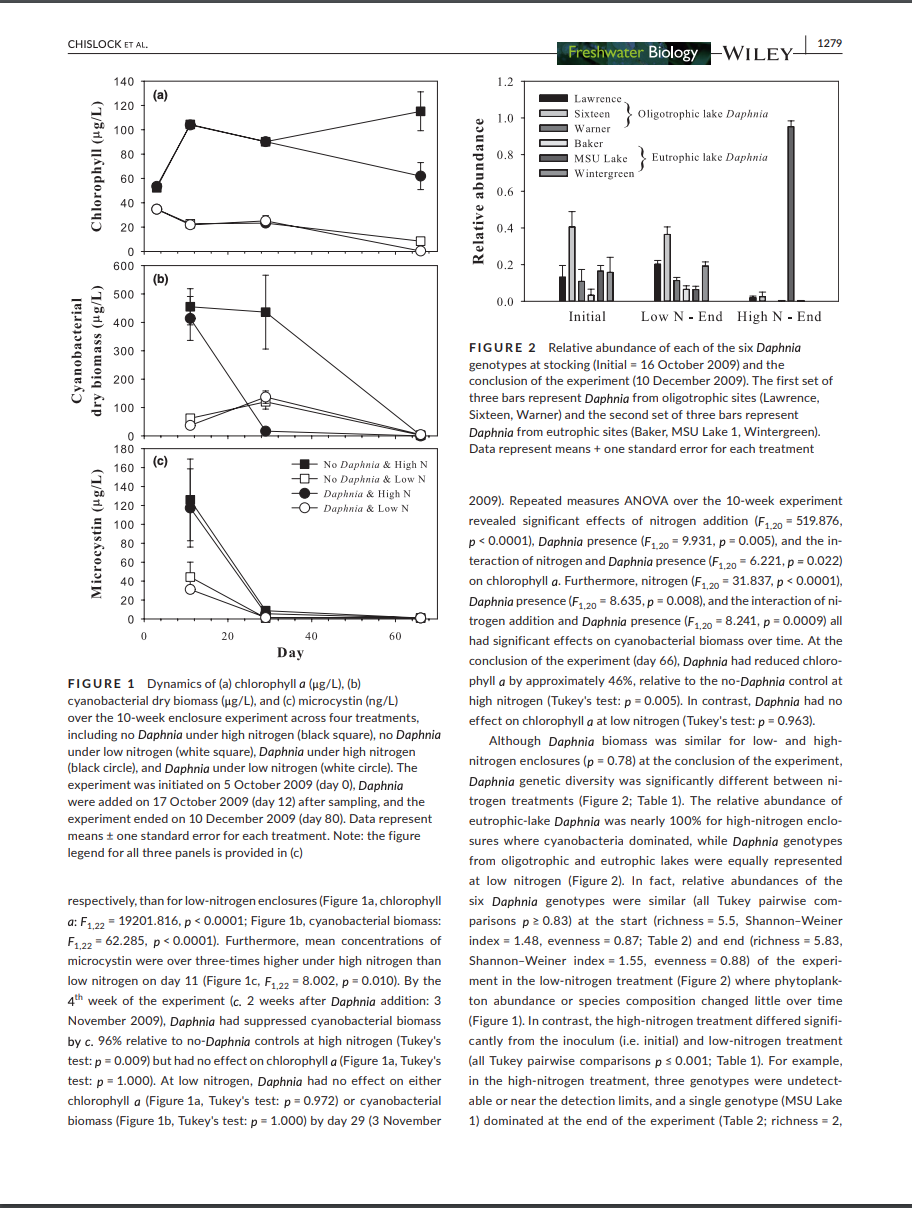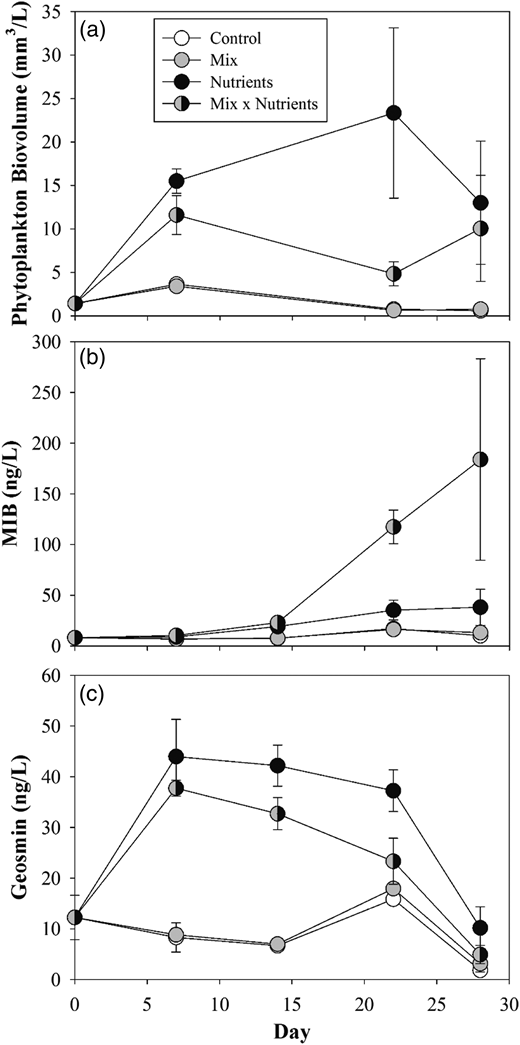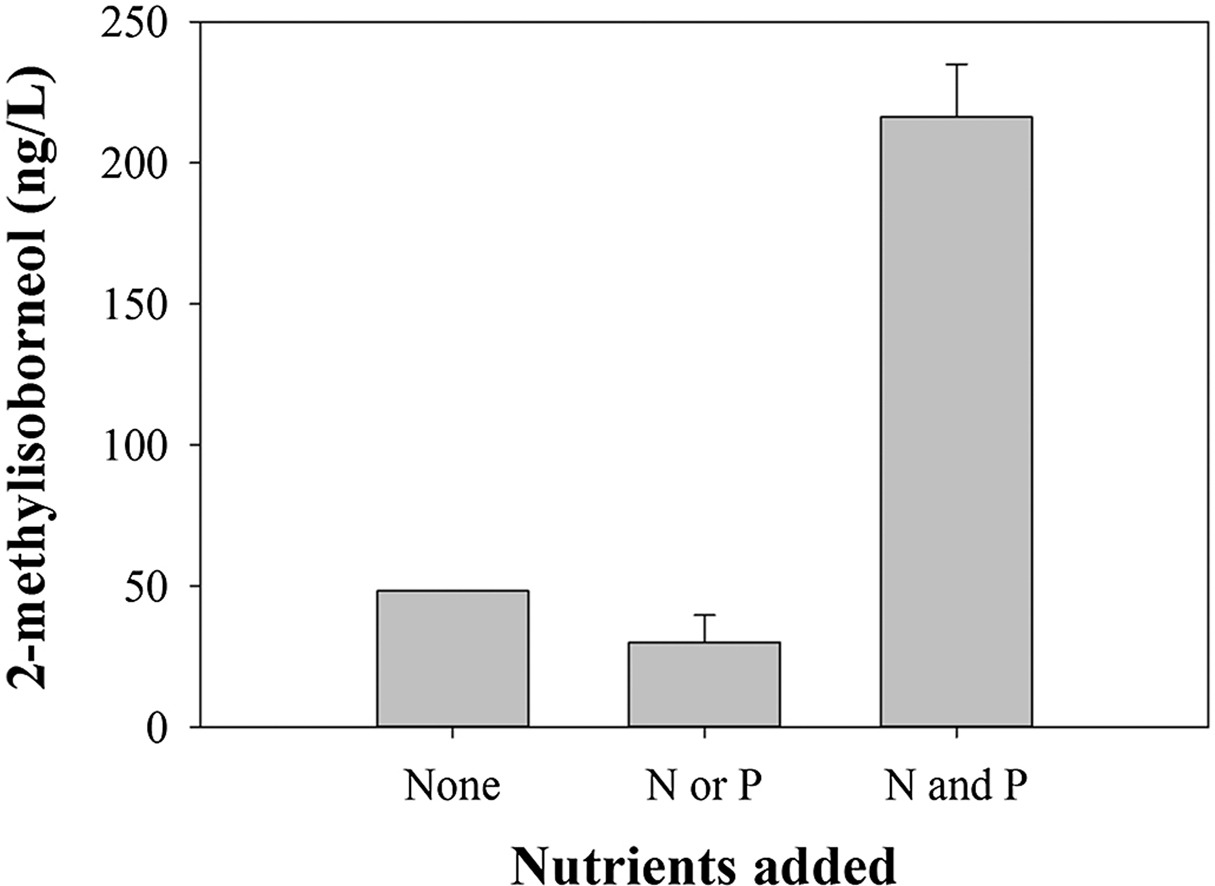Keyword: Nitrogen

Chislock, M. F., O. Sarnelle, L. M. Jernigan, V. R. Anderson, A. Abebe, and A. E. Wilson. 2019. Consumer adaptation mediates top-down regulation across a productivity gradient. Oecologia 190:195-205.
Abstract
Humans have artificially enhanced the productivity of terrestrial and aquatic ecosystems on a global scale by increasing nutrient loading. While the consequences of eutrophication are well known (e.g., harmful algal blooms and toxic cyanobacteria), most studies tend to examine short-term responses relative to the time scales of heritable adaptive change. Thus, the potential role of adaptation by organisms in stabilizing the response of ecological systems to such perturbations is largely unknown. We tested the hypothesis that adaptation by a generalist consumer (Daphnia pulicaria) to toxic prey (cyanobacteria) mediates the response of plankton communities to nutrient enrichment. Overall, the strength of Daphnia’s top–down effect on primary producer biomass increased with productivity. However, these effects were contingent on prey traits (e.g., rare vs. common toxic cyanobacteria) and consumer genotype (i.e., tolerant vs sensitive to toxic cyanobacteria). Tolerant Daphnia strongly suppressed toxic cyanobacteria in nutrient-rich ponds, but sensitive Daphnia did not. In contrast, both tolerant and sensitive Daphnia genotypes had comparable effects on producer biomass when toxic cyanobacteria were absent. Our results demonstrate that organismal adaptation is critical for understanding and predicting ecosystem-level consequences of anthropogenic environmental perturbations.

Chislock, M. F., R. B. Kaul, K. A. Durham, O. Sarnelle, and A. E. Wilson. 2019. Eutrophication mediates rapid clonal evolution in Daphnia pulicaria. Freshwater Biology 64:1275-1283.
Abstract
- Laboratory studies have revealed that Daphnia species can evolve to tolerate toxic cyanobacteria in the diet. Specifically, Daphnia from eutrophic lakes where cyanobacteria are common tend to have higher growth rates and survival when fed toxic cyanobacteria than populations from oligotrophic environments with low abundance of cyanobacteria.
- We conducted an in‐lake mesocosm (i.e. limnocorral) experiment during the autumn of 2009 to assess the effects of nutrient enrichment on clonal evolution in Daphnia pulicaria. As nutrient enrichment often favours grazing‐resistant cyanobacteria, we hypothesised that fertilisation would influence the genotypic composition of D. pulicaria that vary in tolerance to cyanobacteria. Mesocosms were fertilised to manipulate phytoplankton and cyanobacterial abundance and concentrations of a cyanobacterial toxin (microcystin). Thus, half of the mesocosms were high‐nutrient and half were low‐nutrient. We then stocked half of the mesocosms with a mixture of six genetically‐distinct D. pulicaria genotypes (three genotypes from oligotrophic lakes and three from eutrophic lakes) leaving half of the mesocosms Daphnia‐free to assess grazing effects, using a fully factorial design.
- When compared to the low nutrient treatment, high nutrient mesocosms had nearly five‐fold higher chlorophyll a concentrations, eight‐fold higher cyanobacterial dry biomass, and three‐fold higher microcystin levels at the start of the experiment. In contrast, low nutrient mesocosms had phytoplankton concentrations typical of mesotrophic lakes.
- Fertilisation strongly affected Daphnia genetic diversity in the mesocosms. Final Daphnia genotype diversity in the mesocosms with low‐cyanobacteria (richness = 5.83, Shannon–Weiner index = 1.55, evenness = 0.88) was similar to the initial stocked diversity (richness = 5.50, Shannon–Weiner index = 1.48, evenness = 0.87). In contrast, final diversity in fertilised mesocosms with high cyanobacteria was greatly reduced (richness = 2, Shannon–Weiner index = 0.17), with one Daphnia genotype that originated from the most‐eutrophic lake being highly dominant (evenness = 0.25). Thus, eutrophication mediated strong clonal selection of a cyanobacteria‐tolerant Daphnia genotype over just 10 weeks.
- By the end of the experiment, Daphnia significantly reduced phytoplankton biomass in the high‐nutrient, but not in the low‐nutrient treatment. This difference in effect size was largely driven by the five‐fold higher initial phytoplankton biomass in the high‐nutrient treatment. Thus, the ability of Daphnia to reduce phytoplankton biomass in eutrophic lakes may be driven more so by the abundance of planktivorous fishes, as opposed to the prevalence of cyanobacteria and their associated toxins.

Olsen, B. K., M. F. Chislock, A. Rebelein, and A. E. Wilson. 2017. Nutrient enrichment and vertical mixing mediate 2-methylisoborneol and geosmin concentrations in a drinking water reservoir. Water Science and Technology: Water Supply 17(2):500-507.
Abstract
Few ecosystem-level studies have experimentally determined the physicochemical and biological factors that mediate concentrations of off-flavor compounds in drinking water reservoirs. Consequently, the watershed-scale mechanisms determining production of these compounds are still poorly understood. In a recent study, the addition of both nitrogen and phosphorus significantly increased 2-methylisoborneol (MIB). Not surprisingly, MIB was correlated with cyanobacterial abundance (a well-known producer of off-flavor compounds); however, MIB was most strongly correlated with diatom abundance. To empirically test for differences in the production of two important off-flavor compounds, specifically MIB and geosmin, by either cyanobacteria or diatoms, we conducted a fully factorial experiment that manipulated two factors that typically promote cyanobacteria (nitrogen and phosphorus fertilization) or diatoms (vertical mixing of the water column). As predicted, fertilization promoted cyanobacteria, and vertical mixing favored diatoms. Interestingly, the production of geosmin was rapid and consistent with an increase in cyanobacteria while MIB production increased later in the experiment when cyanobacterial biovolume tended to decline and diatom biovolume increased. Based on our current and previous studies, MIB and geosmin production is associated with cyanobacteria, but the direct or indirect influence of diatoms on production should not be ignored.

Olsen, B. K., M. F. Chislock, and A. E. Wilson. 2016. Eutrophication mediates a common off-flavor compound, 2-methylisoborneol, in a drinking water reservoir. Water Research 92:228-234.
Abstract
Off-flavors, such as 2-methylisoborneol (MIB) and geosmin, cause drinking water to have earthy or musty tastes and odors. Humans can detect such compounds at minute concentrations (10 and 30 ng/L for MIB and geosmin, respectively), and, although not a health risk, off-flavors can promote consumer distrust. Removal of these compounds is costly and often unreliable or only suitable under certain conditions. Minimizing off-flavor production at the watershed-scale may be more cost-effective in addition to improving ecosystem health and aesthetics. Cyanobacteria are considered to be the primary drivers of off-flavors in freshwater systems. Due to their ability to produce toxins, cyanobacteria have been under particular scrutiny, and environmental factors promoting cyanobacterial blooms are relatively well-studied. Using this body of literature, we conducted a seven-week, limnocorral experiment where we manipulated nitrogen and nitrogen-to-phosphorus concentrations to influence phytoplankton community structure and off-flavor production. The addition of a single nutrient across broad ranges (nitrogen or phosphorus) had no effect on MIB. However, the addition of both nitrogen and phosphorus promoted high concentrations of MIB relative to treatments that received no nutrients (448% increase) or only nitrogen or phosphorus (722% increase). Interestingly, cyanobacteria waned during the experiment and were replaced by diatoms, which were the dominant taxa by the end of the experiment. Our findings clearly show that eutrophication affects MIB production, but mechanisms leading to the production of this compound may differ from what has been previously predicted.